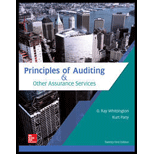
Principles Of Auditing & Other Assurance Services
21st Edition
ISBN: 9781259916984
Author: WHITTINGTON, Ray, Pany, Kurt
Publisher: Mcgraw-hill Education,
expand_more
expand_more
format_list_bulleted
Question
Chapter 10, Problem 40OQ
To determine
Indicate the auditing procedure for the possible misstatement due to error and fraud.
Expert Solution & Answer
Want to see the full answer?
Check out a sample textbook solution
Students have asked these similar questions
Financial Accounting
Two investors are evaluating Anywhere e-SIM Ltd.’s stock for possiblepurchase. They agree on the expected value of D1 and also on theexpected future dividend growth rate. Further, they agree on theriskiness of the stock. However, one investor normally holds stocksfor 2 years, while the other normally holds stocks for 10 years.Is it true that they should both be willing to pay the same price forthis stock? Explain based on how stocks are valued and provide anumerical example to support your arguments.
Please need answer the accounting question
Chapter 10 Solutions
Principles Of Auditing & Other Assurance Services
Ch. 10 - Prob. 1RQCh. 10 - Prob. 2RQCh. 10 - Prob. 3RQCh. 10 - Prob. 4RQCh. 10 - Prob. 5RQCh. 10 - Prob. 6RQCh. 10 - Prob. 7RQCh. 10 - Prob. 8RQCh. 10 - Prob. 9RQCh. 10 - Prob. 10RQ
Ch. 10 - Prepare an example of lapping of cash receipts,...Ch. 10 - Prob. 12RQCh. 10 - Prob. 13RQCh. 10 - Prob. 14RQCh. 10 - Prob. 15RQCh. 10 - Prob. 16RQCh. 10 - Explain two procedures by which auditors may...Ch. 10 - Prob. 18RQCh. 10 - Prob. 19RQCh. 10 - Prob. 20RQCh. 10 - Prob. 21RQCh. 10 - Prob. 22RQCh. 10 - Prob. 23RQCh. 10 - Prob. 24RQCh. 10 - Prob. 25RQCh. 10 - Prob. 26QRACh. 10 - Henry Mills is responsible for preparing checks,...Ch. 10 - During the first few months of the year, John...Ch. 10 - Prob. 29QRACh. 10 - Prob. 30QRACh. 10 - Prob. 31QRACh. 10 - Prob. 32QRACh. 10 - Prob. 33QRACh. 10 - Prob. 34QRACh. 10 - Prob. 35QRACh. 10 - Prob. 36QRACh. 10 - Prob. 37QRACh. 10 - Select the best answer for each of the following...Ch. 10 - Prob. 38BOQCh. 10 - Prob. 38COQCh. 10 - Prob. 38DOQCh. 10 - Prob. 38EOQCh. 10 - Prob. 38FOQCh. 10 - Reconciliation of the bank account should not be...Ch. 10 - The auditors suspect that a clients cashier is...Ch. 10 - Prob. 38IOQCh. 10 - Prob. 38JOQCh. 10 - Prob. 38KOQCh. 10 - Prob. 38LOQCh. 10 - Which of the following represents a correct...Ch. 10 - Which of the following correctly identifies a risk...Ch. 10 - Which of the following correctly identifies a risk...Ch. 10 - Prob. 39DOQCh. 10 - Prob. 39EOQCh. 10 - Prob. 39FOQCh. 10 - Prob. 40OQCh. 10 - Prob. 41OQCh. 10 - Prob. 42OQCh. 10 - Prob. 43OQCh. 10 - Prob. 44OQCh. 10 - Prob. 45OQCh. 10 - Prob. 46PCh. 10 - Prob. 47PCh. 10 - Prob. 48PCh. 10 - Prob. 49PCh. 10 - Prob. 50ITCCh. 10 - Prob. 51ITCCh. 10 - Prob. 52RDCCh. 10 - Prob. 53EC
Knowledge Booster
Similar questions
arrow_back_ios
SEE MORE QUESTIONS
arrow_forward_ios
Recommended textbooks for you
 Auditing: A Risk Based-Approach (MindTap Course L...AccountingISBN:9781337619455Author:Karla M Johnstone, Audrey A. Gramling, Larry E. RittenbergPublisher:Cengage Learning
Auditing: A Risk Based-Approach (MindTap Course L...AccountingISBN:9781337619455Author:Karla M Johnstone, Audrey A. Gramling, Larry E. RittenbergPublisher:Cengage Learning Auditing: A Risk Based-Approach to Conducting a Q...AccountingISBN:9781305080577Author:Karla M Johnstone, Audrey A. Gramling, Larry E. RittenbergPublisher:South-Western College Pub
Auditing: A Risk Based-Approach to Conducting a Q...AccountingISBN:9781305080577Author:Karla M Johnstone, Audrey A. Gramling, Larry E. RittenbergPublisher:South-Western College Pub

Auditing: A Risk Based-Approach (MindTap Course L...
Accounting
ISBN:9781337619455
Author:Karla M Johnstone, Audrey A. Gramling, Larry E. Rittenberg
Publisher:Cengage Learning

Auditing: A Risk Based-Approach to Conducting a Q...
Accounting
ISBN:9781305080577
Author:Karla M Johnstone, Audrey A. Gramling, Larry E. Rittenberg
Publisher:South-Western College Pub